A Q&A with AccessFintech and Broadridge
Justin Llewellyn-Jones, Head of Capital Markets North America, Broadridge
Roy Saadon, CEO and Co-Founder, AccessFintech
Broadridge and AccessFintech announced their partnership back in March. Could you give us an idea of the background to this collaboration?
Justin Llewellyn-Jones
At Broadridge, we recognise that we don’t encompass the full lifecycle of systems that our clients use. We identified a need to partner with other actors more seamlessly within the financial ecosystem and make it easier for clients to cover their business needs.
Within settlement processing, there was a lot of inefficiency and manual intervention. The combination of Broadridge’s post-trade solutions and data with AccessFintech’s workflow solutions and automation seemed like an obvious place to start a partnership.
Roy Saadon
The fundamental building block of the network is quality data. Partnering the data that Broadridge brings together with the network reduces so many hurdles for the banks. There is a lot of value there and the market is reacting to that.
One of the main thrusts of the partnership was the new workplace solution around settlement fails. Can you update us on how that has developed over the past few months since you began the partnership?
Roy Saadon
By blending information, we’re shortening and changing the timeline. If the initial objective was: “Let’s help you fix fails after they happen, but do it in quicker timelines,” by looking at information, we can start talking about: “How do I fix the fails in their exception phase when it’s a lot cheaper and not wait for them to fail?”
Justin Llewellyn-Jones
The simplification of the data and the manner in which that is standardised and provided to AccessFintech is a major catalyst for other activities.
You shift timelines and the ability to resolve fails early or even predict fails is vital. The most valuable part of this initially is to get the data right and get it over in a real-time manner.
In terms of the pain points, which ones are you particularly resolved on addressing, beyond the ones you’ve already mentioned, and where is this partnership working best?
Justin Llewellyn-Jones
The first pain point is making sure that the extraction and ingestion of data is seamless, because that changes the paradigm. You’re going from projects that could take months, if not years, to projects that can take weeks.
Roy Saadon
The ability to tap into the golden source of the banks as a custom integration involves years of initiative. The cost to the bank is tremendous. The ability to flip a switch and open up the data flow in a way that is already compatible with the network is a game-changing event.
How can clients visualise the settlement fails and what benefits are they seeing from this joint approach?
Roy Saadon
Creating a true representation of what the market thinks about the transaction, the different phases of the transaction, and putting an audit trail on it gives me the ability to remove potential fails out of the ecosystem by identifying them early; it shortens the ability to fix those activities, and it changes the whole process completely.
Justin Llewellyn-Jones
Once you have the data, you get to think about automation and digitization. We’re eliminating the effect of having to move between systems. You get rid of manual interventions and you eliminate to some extent human error. If you look at the underlying causes of a lot of settlement fails, it’s very repeatable: either human error, SSI instruction problems, or whatever it may be. Typically, it’s hard to automate the resolution of those because data is not being consolidated into a single place.
I want to ask about what feedback you’ve had from clients on the combination. We talked a bit about the benefits – what are they saying to you?
Justin Llewellyn-Jones
The first benefit is the cost of integration. In financial services technology, integration is almost always the biggest pain point. You get two systems. You try to integrate them and then you have problems.
The first piece of feedback we’ve been getting from clients is: “Thank you for taking that problem away from me,” because they then get to divert their technology and operations resources into things which are actually value-added and can drive some differentiation.
The second piece of feedback we’ve been getting relates to time to market. There is increased desire for business agility and to move quicker.
Roy Saadon
People become jaded after working in a bank. When we go and tell them we’ve come up with a way of shortening what is usually an incredibly long and painful effort of not just the technology but the data cleansing, the initial reaction is: “I’ll believe it when I see it.”
Justin Llewellyn-Jones
Sometimes people don’t understand the complexity of integration. There is scepticism, but once people understand what we’ve done, they see that it is a repeatable process and something that they can take advantage of.
What do you think this fintech partnership represents to the market? What do you think people think of it?
Justin Llewellyn-Jones
We are embracing the component-based architectures that many of us have been talking about for years.
The future is going to be component-based ecosystems or certainly cloud-based, real-time, where the vendors to that that ecosystem have pre-integrated and are providing seamless services rather than products that need to be integrated by our clients.
There’s a lot more that Broadridge and AccessFintech can do together. Broadridge is sitting on a mine of data that has a tremendous amount of value, and if we can free that up and give our clients the ability to feed it into solutions like AccessFintech, it’s only going to provide more value and efficiency and, hopefully, more automation in the future as well.
Roy Saadon
We talk a lot about the trapped value that a single organisation cannot free by itself. In the same way that collaboration between banks and buy-side works, collaboration between vendors is a key milestone.
